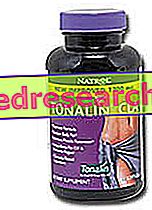
About Tonalin CLA - Natrol
Tonalin CLA - Natrol
Food supplement based on conjugated linoleic acid
FORMAT
Pack of 60/90 capsules
COMPOSITION
Safflower oil containing 80% conjugated linoleic acid; Jelly; Glycerol; Water; Dye: Caramel
Per serving (3 capsules): CLA 2.4 grams
Product features Tonalin CLA - Natrol
Conjugated linoleic acid (CLA) - with the acronym CLA (conjugated linoleic acid) means a series of fatty acids which can be considered as isomers of linoleic acid. All of these are made up of 18 carbon atoms and 2 double bonds separated by a single bond.

Although as we will see later, they are important for the correct functioning of the organism, man does not present the biosynthetic pathways necessary for their synthesis, necessarily having to resort to food intake. Among the richest foods in CLA we find milk with about 0.7% of the total lipid component, followed by meat and some vegetable oils. These guarantee an average daily intake of between 20 and 170 mg, much lower than suggested by the supplementary protocols that with 3.4 gr / die taken orally allow the effective achievement of about 2.7 grams per day, which is around 5-10 times lower than that used in animal models.
Biological role
The importance of CLA in everyday food is not due exclusively to the classic functions described for any other fat, but mainly to the metabolic and biochemical effect documented by a large literature that includes more than 1000 dedicated studies. However, despite the massive amount of work, there remains an aura of mystery regarding the efficacy and safety of CLA in human integrative practice, given the mixed results published and the new experimental evidence.
Therefore, although it is possible to list the various effects described in the many studies, it is necessary to consider that for many of these a molecular explanation is still lacking.
- An anticarcinogenic action: discovered by chance through in vitro culture systems, it was subsequently characterized also on animal models of mammary neoplasms, prostatic, intestinal and pulmonary. The anti neoplastic action should be realized thanks to the modulation of the intracellular signal with the consequent regulation of the cell cycle and of the apoptotic process
Clinical trials on men are still missing.
- Antithrombotic action: particularly important, for the prevention of cardiovascular diseases, it would be explained by regulating cholesterol levels, and by reducing the synthesis of arachidonic acid and its pro-inflammatory and platelet aggregating molecules (thromboxanes, leukotrients and PGE).
- Immuno-modulating action: described also on healthy subjects, it seems to be characterized by a reduction in the levels of IgE (responsible for allergic reactions) and inflammatory cytokines, in favor instead of an enhancement of the specific immune response.
- Fat reduction: implemented through a series of metabolic characteristics:
- Inhibition of the enzyme lipoprotein lipase;
- Increased expression of uncoupling proteins;
- Induction of apoptosis of pre-adipocytes;
- Increased efficiency of the beta oxidation process;
- Increased muscle energy expenditure.
CLA and sports use

Rationale - Tonalin CLA - Natrol
The careful critical evaluation of the various studies proposed by the scientific world offers particularly important points for reflection. First of all it is easy to observe a clear discrepancy between the results obtained by the various research groups, many of which are in complete contradiction without an apparent reason, furthermore it is possible to notice that the results obtained on animal models are clearly more significant and incisive than those obtained man. A possible explanation for this very confusing picture could derive from:
- Very high inter-species and intra-species biological variability;
- Discordance between dosages used in laboratory guinea pigs and those used on men;
- Different biological effect of the various isomers;
- Absence of molecular mechanisms;
All these factors should guide the reader towards a correct interpretation of the results and benefits described by the manufacturing companies, always evaluating a marked critical sense.
Recommended use by company - Tonalin CLA - Natrol
It is recommended to take 1 capsule three times a day with meals.
Use in sports - Tonalin CLA - Natrol
As mentioned at the beginning, the dosages described in the various studies are very different, especially when switching from animal models to clinical trials on healthy individuals. Today the most common application range is from 2 grams / day to 6 grams per day considering that its bioavailability is around 70%. Among all the proposed studies, the most replicated dosage is 3.4 grams per day in several administrations at more or less regular time intervals.
Administration should be preferred during meals.
Efficacy in weight loss (estimated around 0.09kg / week, linear in the first six months) is achieved by prolonged time intervals for which medical advice is essential.
Tonalin synergies CLA - Natrol
DIETARY PLAN AND PHYSICAL ACTIVITY: in order for CLA to assist weight loss, it is NECESSARY to program a controlled, healthy and possibly low-calorie diet, associated with a programmed physical activity adapted to individual needs.
Also in this case it is possible to describe some studies carried out on animals that associate CLA to arginine, recording positive effects on the increase in lean mass, but which make little sense, given the absence of the equivalent in humans.
Side effects Tonalin CLA - Natrol
Despite the absence of serious side effects recorded following the intake of CLA, there are various reports of possible pejorative effects in various pathological conditions:
- Increase in inflammatory biomarkers (reactive c protein and white blood cells): despite these findings, CLA has proved particularly useful due to its anti-inflammatory properties.
- Increase in insulin resistance: this effect, which seems to be more pronounced for the T10, C12 isomer, drops significantly when an evenly composed mixture is used.
- Increased oxidative stress: increased lipoperoxidation levels.
- Dyslipidemic effect: associated with the T10 isomer, C12 materializes with a reduction in plasma HDL cholesterol levels, with an increase in LDL.
Precautions for use Tonalin CLA - Natrol
The product is contraindicated in cases of renal or hepatic disease, cardiovascular disease and / or hypertension, during pregnancy, during lactation and under 14 years. In the event of prolonged use (over 6/8 weeks), medical advice is required.
This article, elaborated on the critical re-reading of scientific articles, university texts and common practice, is for informational purposes only and is therefore not a medical prescription. It is therefore always necessary to consult your doctor, nutritionist or pharmacist before starting to use any kind of supplement . Further information on the critical analysis of Tonalin CLA - Natrol.
| BIBLIOGRAPHY |
. November; 44 (11): 975-82. Epub 2009 Sep 25. Conjugated linoleic acid induces uncoupling protein 1 in white adipose tissue of ob / ob mice. Wendel AA, Purushotham A, Liu LF, Belury MA. Nutr Rev. 2008 Jul; 66 (7): 415-21. Plourde M, Jew S, Cunnane SC, Jones PJ. Eur J Clin Nutr. 2003 Oct; 57 (10): 1268-74. Effect of conjugated linoleic acid supplementation after weight loss on appetite and food intake in overweight subjects.Kamphuis MM, Lejeune MP, Saris WH, Westerterp-Plantenga MS. J Food Sci. 2007 Oct; 72 (8): S612-7. Conjugated linoleic acid (CLA) prevents body fat accumulation and weight gain in an animal model.Park Y, Albright KJ, Storkson JM, Liu W, Pariza MW. J Nutr Biochem. 2008 Jan; 19 (1): 61-8. Epub 2007 May 24. Chromium picolinate and conjugated linoleic acid do not synergistically influence diet and exercise-induced changes in body composition and health indexes in overweight women.Diaz ML, Watkins BA, Li Y, Anderson RA, Campbell WW. No synergistic effect Am J Clin Nutr. 2007 May; 85 (5): 1203-11. Whigham LD, Watras AC, Schoeller DA. J Nutr. 2005 Apr; 135 (4): 778-84. Supplementation with conjugated linoleic acid for 24 months is well tolerated by body fat mass in healthy, overweight humans.Gaullier JM, Halse J, Høye K, Kristiansen K, Fagertun H, Vik H, Gudmundsen O. Lipids. 2009 Nov; 44 (11): 983-8. Epub 2009 Oct 23. Conjugated linoleic acid isomers, t10c12 and c9t11, are differentially incorporated into adipose tissue and skeletal muscle in humans.Goedecke JH, Rae DE, Smuts CM, Lambert EV, O'Shea M. J Nutr. 2009 Jul; 139 (7): 1279-85. Epub 2009 May 13. Dietary supplementation of L-arginine and conjugated linoleic acid reduces retroperitoneal fat mass and increases lean body mass in rats.Nall JL, Wu G, Kim KH, Choi CW, Smith SB. Int J Obes (Lond). 2007 Mar; 31 (3): 481-7. Epub 2006 Aug 22. The role of conjugated linoleic acid in reducing body fat and preventing holiday weight gain.Watras AC, Buchholz AC, Close RN, Zhang Z, Schoeller DA. Riserus U, Arner P, Brismar K, Vessby B. Treatment with dietary trans10cis12 conjugated linoleic acid causes isomer-specific insulin resistance in obese men with the metabolic syndrome. Diabetes Care 2002; 25: 1516-2 Int J Obes Relat Metab Disord. 2003 Jul; 27 (7): 840-7. The effect of conjugated linoleic acid supplementation after weight loss on body weight regain, body composition, and resting metabolic rate in overweight subjects.Kamphuis MM, Lejeune MP, Saris WH, Westerterp-Plantenga MS. Eur J Clin Nutr. 2005 Apr; 59 (4): 508-17. Effect of CLA supplementation on an immune function in young healthy volunteers.Song HJ, Grant I, Round D, Mohede I, Sattar N, Heys SD, Wahle KW. |



